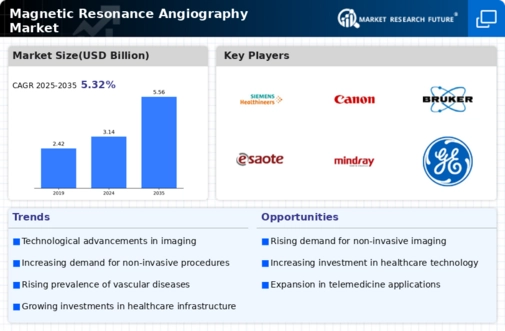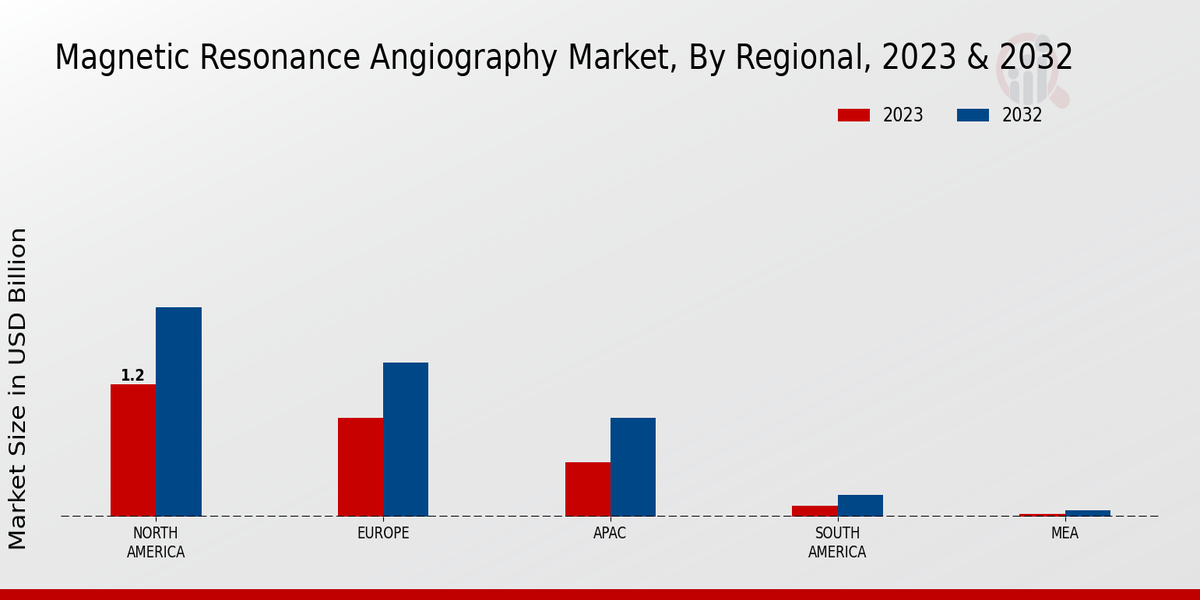Market Growth Projections
The Global Magnetic Resonance Angiography Market Industry is projected to experience robust growth, with estimates indicating a market value of 3.14 USD Billion in 2024 and a potential increase to 5.56 USD Billion by 2035. This growth trajectory suggests a compound annual growth rate of 5.33% from 2025 to 2035. Such projections highlight the increasing reliance on magnetic resonance angiography for vascular imaging and the expanding applications of this technology in clinical practice. As healthcare systems evolve and the demand for precise diagnostic tools rises, the market is likely to witness sustained expansion in the coming years.
Regulatory Support and Reimbursement Policies
Supportive regulatory frameworks and favorable reimbursement policies are vital drivers for the Global Magnetic Resonance Angiography Market Industry. Governments and health organizations are increasingly recognizing the importance of advanced imaging techniques in diagnosing and managing vascular diseases. As a result, there is a growing trend towards establishing reimbursement policies that cover magnetic resonance angiography procedures. This financial backing encourages healthcare providers to adopt these technologies, thereby expanding their availability to patients. Enhanced reimbursement rates and streamlined regulatory approvals are expected to facilitate market growth, ensuring that magnetic resonance angiography remains a cornerstone of modern diagnostic practices.
Rising Investment in Healthcare Infrastructure
The Global Magnetic Resonance Angiography Market Industry is benefitting from increased investments in healthcare infrastructure, particularly in developing regions. Governments and private entities are allocating substantial resources to enhance medical facilities and upgrade imaging technologies. This investment is crucial for expanding access to advanced diagnostic tools like magnetic resonance angiography, which can improve patient outcomes. For example, initiatives to establish modern imaging centers in underserved areas are likely to drive demand for magnetic resonance angiography services. As healthcare infrastructure continues to evolve, the market is poised for sustained growth, aligning with global health improvement goals.
Increasing Prevalence of Cardiovascular Diseases
The rising incidence of cardiovascular diseases globally is a primary driver for the Global Magnetic Resonance Angiography Market Industry. As populations age and lifestyle-related health issues become more prevalent, the demand for non-invasive imaging techniques to assess vascular health is escalating. Magnetic resonance angiography provides critical insights into blood vessel conditions, facilitating timely interventions. The World Health Organization reports that cardiovascular diseases account for a substantial percentage of global mortality, underscoring the need for effective diagnostic tools. This trend is likely to propel the market towards a projected value of 5.56 USD Billion by 2035.
Technological Advancements in Imaging Techniques
The Global Magnetic Resonance Angiography Market Industry is experiencing a surge in demand due to rapid technological advancements in imaging techniques. Innovations such as high-field MRI systems and improved contrast agents enhance image quality and diagnostic accuracy. For instance, the introduction of 7 Tesla MRI systems allows for unprecedented detail in vascular imaging, which is crucial for identifying conditions like aneurysms and vascular malformations. This technological evolution is expected to contribute significantly to the market's growth, with projections indicating a market value of 3.14 USD Billion in 2024, reflecting a growing reliance on advanced imaging modalities.
Growing Awareness and Adoption of Non-Invasive Procedures
There is a notable increase in awareness regarding the benefits of non-invasive diagnostic procedures, which is positively influencing the Global Magnetic Resonance Angiography Market Industry. Patients and healthcare providers are increasingly recognizing the advantages of magnetic resonance angiography over traditional invasive techniques, such as angiography. This shift is driven by the lower risk of complications and the ability to obtain comprehensive vascular images without the need for catheters. As healthcare systems worldwide promote patient-centric approaches, the adoption of magnetic resonance angiography is expected to rise, contributing to a compound annual growth rate of 5.33% from 2025 to 2035.












